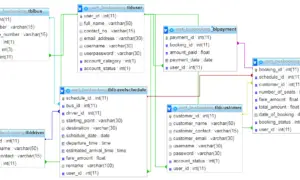Online Platform for Social Welfare and Development
The article presents the different development tools in the development of the online platform and as well as some relevant articles and studies that will help in the research study of the proponents.
The project entitled Online Platform for Social Welfare and Development will focus on the monitoring of donations and to ensure that the transactions will be easier and efficient.
REVIEW OF RELATED LITERATURE
In developing a website, there are a lot of things you should consider not just on the front end but the back end of the system as well. Here are some essential tools which will be useful in developing a website that can be used in different platform;

HTML
According to Shannon Ross, HTML is a computer language devised to allow website creation. These websites can then be viewed by anyone else connected to the Internet. It is relatively easy to learn, with the basics being accessible to most people in one sitting; and quite powerful in what it allows you to create. It is constantly undergoing revision and evolution to meet the demands and requirements of the growing Internet audience under the direction of the W3C, the organization charged with designing and maintaining the language.
HTML5
HTML5 is markup language for structuring and presenting content for the World Wide Web, and is a core technology of the Internet, originally proposed by Opera Software defined by Sharma, Bhardwaj, Bhardwaj (2012). HTML5 is an accepted Web standard, it can create apps that are compatible not only with mobile devices but also desktop and notebook browsers, for a seamless experience across all a user’s devices.
CSS
According to Stark (2012) CSS is a stylesheet language that you use to define the visual presentation of an HTML document. You can use CSS to define simple things like the text color, size, and style (bold, italic, etc.), or complex things like page layout, gradients, opacity, and much more. Property names are predefined in the CSS specification, which means that you can’t just make them up. Each property expects an appropriate value, and there can be lots of appropriate values and value formats for a given property.
BOOTSTRAP
Bootstrap is an open-source Javascript framework developed by the team at Twitter. It is a combination of HTML, CSS, and Javascript code designed to help build user interface components. Bootstrap was also programmed to support both HTML5 and CSS3. Also, it is called Front-end-framework. Bootstrap is a free collection of tools for creating a websites and web applications. It contains HTML and CSS-based design templates for typography, forms, buttons, navigation and other interface components, as well as optional JavaScript extensions.
Some Reasons for programmers preferred Bootstrap Framework:
- Easy to get started
- Great grid system
- Base styling for most HTML elements (Typography, Code, Tables, Forms, Buttons, Images, Icons)
- Extensive list of components
- Bundled JavaScript plugins
CODEIGNITER
CodeIgniter is a powerful PHP framework that can help you greatly speed up the development of your web applications. It is having a small performance footprint due to the modular approach to loading its libraries and does a great job separating logic from presentation by using a Model-View-Controller (MVC) dynamic.
JAVASCRIPT
JavaScript (often shortened to JS) is a lightweight, interpreted, object-oriented language with first-class functions, and is best known as the scripting language for Web pages, but it’s used in many non-browser environments as well. It is a prototype-based, multi-paradigm scripting language that is dynamic, and supports object-oriented, imperative, and functional programming styles.
PHP
PHP is an HTML-embedded scripting language. Much of its syntax is borrowed from C, Java and Perl with a couple of unique PHP-specific features thrown in. The goal of the language is to allow web developers to write dynamically generated pages quickly. It is a widely-used open source general-purpose scripting language that is especially suited for web development and can be embedded into HTML. (What is PHP? n.d.)
JSON
JSON, or JavaScript Object Notation, is a minimal, readable format for structuring data. It is used primarily to transmit data between a server and web application, as an alternative to XML. Squarespace uses JSON to store and organize site content created with the CMS. JSON is a text format that is completely language independent but uses conventions that are familiar to programmers of the C-family of languages, including C, C++, C#, Java, JavaScript, Perl, Python, and many others. These properties make JSON an ideal data-interchange language.
Related System
Pug Ngai (2008), article discusses the dormitory labor system, a specific Chinese labor system through which the lives of Chinese women migrant workers are shaped by the international division of labor. This dormitory labor system is a gendered form of labor use that underlies the boom of export-oriented industrial production in China, which has been further boosted by China’s accession to the World Trade Organization. Combining work and residence under the dormitory labor system, production and daily reproduction of labor are reconfigured for the sake of global production, with foreign-invested or privately-owned companies controlling almost all daily reproduction of labor. Drawing upon the findings of a 2003 – 4 case study of an electronics factory in South China, this paper analyzes the operation of the dormitory labor system, detailing both its role in increasing output and profits and its role in supporting workers’ resistance to their employers.
Manmang Pen (2009), the students’ dormitory is the main place to college students’ daily life, so the students’ dormitory management is an important part of school management. As the growth of the school recruitment of students’ scale, the growing number of students, make the student dormitory management faced with multiple, complex, complex situation. The problem of how to decipher, become the focus of the school logistics department leadership focus on. In order to adapt to the needs of the development of the school, and further improve the efficiency of school logistics work, school logistics department need a adapt to student dormitory daily management software system, in order to give full play to the advantages of modern information technology and Internet, realize the artificial management to change the way of computer management, increases the working efficiency of the dormitory management.
Jitka Novotová, Jozefina Simová and Jitka Vávrová (2008) addresses the implementation of Internet marketing communications for feedback collection by accommodation facilities in the Czech Republic, particularly in northern and eastern Bohemia. The primary goal of the present paper was to analyze the extent and the tools used to help Czech lodging establishments collect feedback from their customers. Data were collected during an online survey targeting the managers and owners of accommodation facilities in the selected areas. This research revealed that personal interviews, email and social networks are the most commonly used feedback tools. We also discovered that large lodging establishments with more than 29 beds implemented the highest number of feedback tools. In terms of customer acquisition, 81% of the respondents evaluated web-based feedback instruments as very effective. We showed that publicly shared reviews are considered to have a significant impact on customer behavior.
HUI LIU, MIN WEI (2017) states that, in order to improve the utilization rate of college residential resources and the efficiency of management personnel, we decided to develop Xiamen University apartment management system. The development and realization of the system helps to improve the overall efficiency of student apartment management. This paper presents how the graduate students select their own dormitories through the network system for the first time, by showing the process in which students, college administrators and apartment administrator are involved. The development of apartment management system aims to optimize the work process, adopt scientific management, and improve work efficiency. This system is applied to the management of college apartment with good effect. At last, a summary and forecast are given to the system.
Panditharathna (2009) Managing a manual booking system is a complex and difficult task for forest circuits in Sri Lanka. Present work deals with the real problem of the manual booking system in the Forest Department of Sri Lanka. In this study, a computerized system, though still not familiarized field in Sri Lanka, is proposed, as a solution to the present inefficient, manual booking system. The interface was implemented using, HTML, Java script, server-side scripting language PHP, and Apache web server as front end and MySQL Database server running as a back end. The entire web based system was designed mainly in five modules (registration module, administration module, check availability module, bookings module and payments module) which were selected by consequent of the study of the activities involved in the system and the task involved. Two Man and Biosphere Reserves, Sinharaja and Kanneliya were selected as sites. Information about sites, availability, details of payments, and the means of contacting the Flora and Fauna Information Unit were included in the Web pages. A user has to log on to the web site to check availability and booking.
ZhengXianga (2010), states that Social media are playing an increasingly important role as information sources for travelers. The goal of this study is to investigate the extent to which social media appear in search engine results in the context of travel-related searches. The study employed a research design that simulates a traveler’s use of a search engine for travel planning by using a set of pre-defined keywords in
combination with nine U.S. tourist destination names. The analysis of the search results showed that social media constitute a substantial part of the search results, indicating that search engines likely direct travelers to social media sites. This study confirms the growing importance of social media in the online tourism domain. It also provides evidence for challenges faced by traditional providers of travel-related information. Implications for tourism marketers in terms of online marketing strategies are discussed.
Rob Law, Cathy H. C. Hsu (2006) The recent introduction of Internet technology to general business has led to its wide-scale application in the hotel industry. Consumers have been increasingly using the Internet to search for accommodation-related information on hotel Websites. To facilitate a better understanding of e-commerce, hospitality and tourism researchers have shown the importance of establishing content-rich and user-friendly Websites. The existing hospitality literature, however, has a very limited number of published articles that investigated the perceptions of hotel Website users on the importance of specific features on hotel Websites. The absence of prior studies on assessing the importance of hotel Website dimensions and attributes is particularly true in the comparison of online browsers who only search for information and online purchasers who have made online bookings. This article reports on a study that examined these two groups of international hotel Website users on their perceived importance level of specific dimensions and attributes on hotel Websites. Empirical evidence indicates that there was no significant difference in most of the included dimensions and attributes between these two groups of users.
Credits to the author/developer of the project
You may visit our Facebook page for more information, inquiries, and comments. Please subscribe also to our YouTube Channel to receive free capstone projects resources and computer programming tutorials.
Hire our team to do the project.


